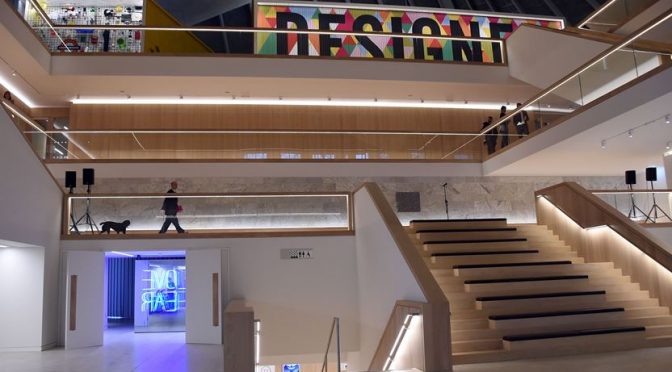Willmott Dixon Interiors delivered the fit-out and refurbishment of London’s most important cultural project for 2016; creating a new home for the Design Museum as it moves from its Shad Thames location to Kensington. With all eyes on the work, we interviewed the project team charged with creating a landmark that will attract over 650,000 people a year.
Many people go into the construction industry with a desire to be able to say ‘I built that’ about landmark buildings.
Lewis Hepburn, from Willmott Dixon Interiors (WDI) is one of them. As Construction Manager on our £23 million project to fit-out the Design Museum’s new home in Kensington, Lewis is in the spotlight.
DESIGN ICON
WDI’s role in this iconic project was to turn the old building into a space ready for the Design Museum’s own team, for them to complete the final phase and install the exhibits. Part of this refurbishment was to retain the existing parabolic roof structure.
Lewis explains, “It’s about altering the existing building to suit the museum while saving some of the existing features. I would say it’s the most important fit-out in London as it will attract 650,000 visitors when open and also has free entry. ”
Interiors got the go-ahead on the contract in January 2015, but an award was not confirmed due to delays on the previous phase. Apart from a weekly two-hour visit, Lewis and the team were not allowed on site for nearly five months after winning the job, but that time was not wasted.
DE-RISK
“ To overcome this challenge we used that time to de-risk the project and look at all the cost details and for any gaps in the design in order to flesh them out early,” explains Lewis. “That was quite successful but we couldn’t complete it entirely as we couldn’t get in the actual building, so all the mechanical and electrical work at that point was all theory.”
The fit-out work covered six floors from lower basement up to a second floor. The challenge has been to meet the quality in the design brief specified by architects John Pawson and OMA. Lewis continues, “The difficulty is the quality of the finishes and the need to make that look good can be a challenge. It’s the finite detail. Our build part is the permanent exhibition, so it couldn’t overwhelm the temporary exhibitions. What John Pawson has done is quite subtle.”
Lewis gives the example that the second floor has oak paneling and floors. The joinery is particularly significant and this package is valued at around £1 million out of a £23 million construction cost.
Lewis adds, “There was a lot of metal and timber cladding and getting those junctions with the floors and ceilings was important. They are very particular with the design and we have been working with them to incorporate the M&E.”
KEY CHALLENGE
Giving an example of the challenges faced with the mechanical & engineering (M&E) aspect of the job, Lewis talks about a 300m-glass balustrade with a timber handrail fitted with LED lights that he describes as “very tricky to say the least”.
The team also had to ensure that none of the M&E work was visible in certain sections, such as the second floor, which features designer in-residence rooms. This involved taking up positions in various parts of the building to make sure that no M&E work could be seen and where it was, be promptly hidden.
SUMMER PEAK
The works at the new museum peaked in May, when nearly 150 people were on site. This included a team from WDI working on the design and supervising construction whilst occupied by other contractors. Lewis was supported by Principal Surveyor Darren Sample and Andy Horrocks, was in charge of Technical Services and has played a key role in unifying the design and construction team.
“Andy has played a major part in the coordination of the architectural and services teams working together,” says Lewis.
SUSTAINABILITY & ENVIRONMENTAL ACHIEVEMENTS
The New Design Museum building has been designed to BREEAM ‘Very Good’ rating; defined as a low carbon building. The sustainable highlights of the building include efficient heating system, which is controlled under a Building Management System (BMS), controlling and monitoring the lighting, heating and ventilation, which enables the occupants to reduce their usage. There are Passive Infrared (PIR) Sensors on the majority of the spaces and therefore lighting is only used when occupants are present, saving energy. The average day lighting factor and thermal comfort levels are above the average, increasing the occupants experience within the building.
‘‘ Willmott Dixon Interiors over-performed on environmental performance comprising carbon, water and waste’’ Lewis Hepburn
Highlights included:
- Achieving 44 in the Considerate Constructors Scheme (CCS), scoring a minimum of 8 (Excellent standards) in each section, equating to an innovative credit under BREEAM. The CCS report quoted: “On the environment the overall effort noted demonstrates an exceptional provision and performance. Sustainability is part of the well-considered environmental policy with positive objectives and approach.”
- Procuring 100% of all timber from a sustainable source (Forest Management and Chain of Custody certification)
- 45% of applicable materials were procured with responsible sourcing certification (i.e. BES6001)
- 100% of non-hazardous construction waste was diverted from landfill, in line with our headline target to achieve 100% diversion from landfill in 2020.
Willmott Dixon Interiors chief operating officer Mike Hart:
“This is a high-profile and prestigious project that will see the Design Museum become one of London’s biggest attractions, with over 500,000 visitors expected annually. We are very proud to have completed the fit out and refurbishment of the museum, especially as we have a long track-record restoring listed buildings into modern spaces fit for the 21st century. We have used our experience to deliver an exceptional home that will showcase our rich cultural heritage.”
The new Design Museum opens on 24th November 2016. Click here for future exhibitions.




